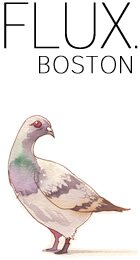70 zebra finches in a room full of amplified guitars.
Admittedly, I was skeptically optimistic heading into from here to ear at the Peabody Essex Museum. Skeptical because, well– I envisioned the birds’ interactions with the instruments to be minimal; much favoring the quiet periphery of the gallery. And I also wondered if a chance alightment would only result in a tinny and discordant note. But that’s when my optimism kicked in.
Thanks to the PEM’s incredible track record for innovative and engaging programming, and with Trevor Smith, the museum’s first Curator of Contemporary Art (recently re-knighted, Curator of the Present Tense) at the helm, I knew I was in for something much more magical than a few timid plucks.
———————–
Needless to say, my skepticism melted away the moment I passed through the chain-link curtains of the gallery. I was welcomed by a string of complex resonant sounds that would each crescendo to become thundering roars and then taper off gently into thin air. It was as if I had pressed ‘scan’ on the radio and was privy to the very best snippets of a post-rock playlist. The delicacy of the birds juxtaposed with the strength of the ambient sound left me completely transfixed.
You quickly come to realize that the finches aren’t really “performing” for us, they have already adapted to their new habitat and are just going about their business; treating the gallery as if it were the great outdoors. We are simply fortunate voyeurs who have a chance to enjoy the byproduct of their temporary environment.
As they go about their daily routine you become fully immersed in their world and bear witness to a full spectrum of animal behaviors. One moment you might find a finch couple nuzzling close on the neck of one of the guitars, and then without warning, your intimate observation will be disrupted by a power-chord scuffle in the distance as another group of birds wildly bicker over their rightful spot on a musical perch.
While the dynamic soundscape is certainly part coincidence, its melody can also be attributed to the deliberate chromatic tuning of the 10 Gibson Les Paul and 4 Thunderbird bass guitars by artist, Céleste Boursier-Mougenot. Boursier-Mougenot, who has a background in music composition, is interested in liberating the rhythms and vibrations of everyday life and believes that “music is waiting to be revealed everywhere”.(via) He worked with the acoustics of the gallery and the particular possibilities of the different amplification settings to ensure, like a good roadie, that the stage was properly set for the finches’ grand performance.
Aside from finch gazing, there is also an interesting fringe psychological component to the exhibit; how do we behave while in their world? We are quite the human zoo. As I was chatting with others in the gallery, I noticed that whenever a guitar rang out, we would all naturally stop speaking. It was almost as if we were quieting down out of respect at the beginning of a concert as the musicians tune their instruments. But these tinkering sounds never launch into a full fledged concerto. And even though it may sound like they are strumming the beginnings of Fight for Your Right to Party, the birds cut you off before you have a chance to belt out the chorus. They just don’t want to hear it.
After the 19 others in my group (only 20 visitors allowed at a time) vacated the aviary, I stayed to chat with Chip Van Dyke, the Media Production Manager at the PEM, who is inadvertently becoming a zebra finch scholar through osmosis. I asked him what happens in the space after hours once the gallery lights dim, and the answer is oddly similar to what you might expect our pets to be doing while we’re at work: sleeping straight up partying.
Apparently the finches freely treat the gallery like their own personal playground. Chip mentioned how he has even seen some of the birds tug at guitar strings in an attempt to steal them away to one of the many nest “condos” that hang high above the gallery.
And while the birds let their hair down once the crowds go home, they are just as eager and inquisitive to investigate the next round of museum goers when they appear the following morning. With heads cocked sideways, they carefully observe us as we make our way around their habitat; flitting towards and repelling away from us. Be prepared for a for a flock to whiz past your head or a chorus of tiny chirps to catch you off guard. And I have to say there is something that feels quite rewarding when a large group of finches land on the guitar you’re standing near–this is your snow white moment.
We help shape the music because they allow us to. The tiny composers could just as easily hide in a quiet corner or a darkened nest, but they choose to be out and about among us, and that curiosity results in a chance composition that is truly unforgettable.
Never before in New England have I encountered an exhibition with live animals flitting about without a barrier in between us. The closest we ever get to experience are their -covers finches’ “ears”- stuffed counterparts at the Harvard Museum of Natural History.
This incredible series, of which the PEM’s installation is the 17th and largest iteration, invites viewers to be a part of an ever changing 3-dimensional score and challenges us to consider the way we perceive, create, and interact with music.
And it is nothing short of magic.
from here to ear will be on view through April 13, 2014 at the Peabody Essex Museum in Salem and you can learn more about the exhibition here. ♥











